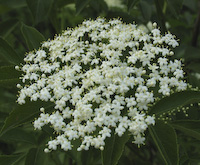Common Elderberry
Sambucus nigra |
 Other common names:
American Elder, Black Elderberry, Canada Elderberry, Common Elder Other common names:
American Elder, Black Elderberry, Canada Elderberry, Common Elder

Other scientific names:
Sambucus canadensis, Sambucus cerulea, Sambucus mexicana, Sambucus orbiculata, Sambucus simpsonii

French names:
Sureau blanc

Family:
Muskroot Family (Adoxaceae), (Honeysuckle Family (Caprifoliaceae))

Group:
Elderberries

Distinctive features:
Shrub

Similar species:
•
Red-berried Elderberry (Sambucus racemosa) - Very similar, berries red, grows in drier habitats (in woods).

Flowers:
Summer; White; 5 parts (petals)

Height:
2 m (6 ft)

Habitat:
Fields and Open Areas, Moist Meadows, Thickets

Edible:
The berries make excellent pies.

Books:
Shrubs of Ontario: 449
Newcomb's Wildflower Guide: 320

Native/Non-native:
Native

Notes:
This native shrub is grown for its fruit (for use in jellies, pies or wine), or its use in landscapes for wildlife habitat.

Origin and Meaning of Names:
Scientific Name: nigra: black

Photographs:
89 photographs available, of which 9 are featured on this page. SCROLL DOWN FOR PHOTOGRAPHS.

 |
 |
|
|
|
|
|
|
|
 |